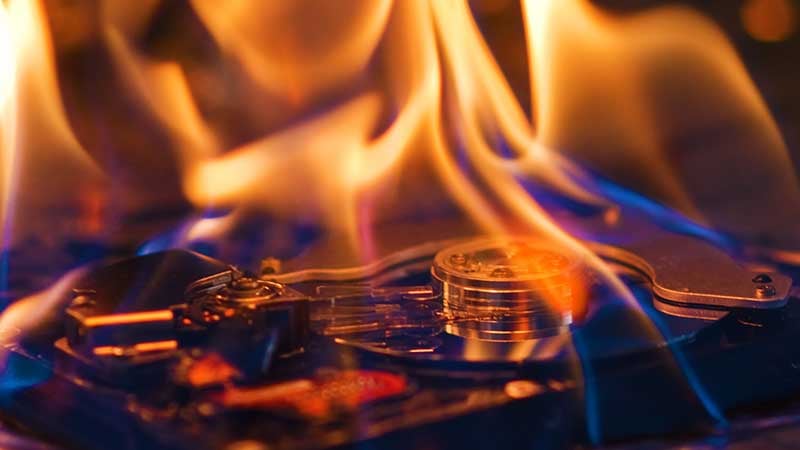Nothing lasts forever, and this includes data storage devices. When it comes to end-of-life hard drive data sanitization and destroying hard drives, you have options. In order to sanitize a magnetic hard drive of all data to NSA Data Sanitization standards, you must either:
- Shred (disintegrate) to 2 mm size on edge.
- Incinerate at temps greater than 670° C (1,238° F).
- Degauss and then physically deform.
Because the NSA requires all processes to be done in a secure environment, not all of these methods are equally effective, safe, or practical.
Hard drive shredding for data sanitization: particles still have data
For data sanitization, there are at least three problems with hard drive shredding to 2 mm particle size:
- It leaves data behind.
- It produces fine particles that if airborne are potentially toxic.
- It requires bulky, power-hungry, heavy machinery.
As of publication, there is currently no NSA-Evaluated Products List (EPL) listed shredders or disintegrators that meet the NSA standard for the 2 mm hard drive shred. Even if you can find the equipment that disintegrates a hard drive to 2 mm, hard drives are made of metal, glass, and ceramic. When shredded into particles the size of rice, those particles, if not handled properly, are poisonous to humans and our environment.
All those metal components make shredders incredibly heavy and immobile. One shredder on the market today which shreds hard drives and laptops to 38 mm weighs 4,200 pounds (1905 kg). That’s as much as 3 full-grown Angus cows!

Hard drive incineration for data sanitization: don’t burn yourself!
Since steel melts at 2,500°F, a steel smelter produces the temperatures to melt a hard drive. However, there are at least four problems with incineration for data sanitization:
- Incineration cannot easily be done in a secure location which, is required by the NSA .
- It releases toxic fumes and produces toxic sludge.
- It can be dangerous to operate (workers require heat-resistant Personal Protective Equipment/PPE).
- It requires a lot of fuel to burn that hot and is not environmentally friendly.
Hard drive degaussing for data sanitization: sanitizes the drive of all data in seconds
The most cost-efficient, fully effective, and fast way to destroy the data on a hard drive is to degauss it. Data on hard drives is stored magnetically. Degaussing eliminates the magnetic field, therefore eliminating the data.
Degaussing for data sanitization is:
- Clean, quiet, and plugs into a standard wall outlet (can be performed inside your facility, office, or data center.)
- Easy to perform, requires no special training or protective equipment.
- Takes seconds to complete and produces no hazardous byproducts.
- Environmentally friendly destroys the data but leaves the media intact to be recycled.
Degaussing (demagnetizing) the drive ensures that the data on the drive is forensically unrecoverable. The degaussing process is simple, you turn the machine on and put the hard drive in its media drawer. Closing the drawer automatically starts the degauss cycle. Because the drive is intact after degaussing, the drive is recyclable for its components. See Garner’s TS-1XT degausser for more information.
NSA data sanitization standards also require degaussed hard drive platters to be physically deformed. Physical destroyers can be as small as a CPU and operate in an office environment. They destroy the drive-by “taco-ing” (bending in half) the drive and mangling its data platters and internal components. As an added environmental benefit, these degaussed and destroyed drives are still recyclable. See Garner’s PD-5 for more information.
Garner Product Inc.’s degaussers and physical destroyers are portable, easy to use and ensure complete data destruction.
Contact Garner today to learn more about degaussing and physical destruction.


LEAVE A REPLY